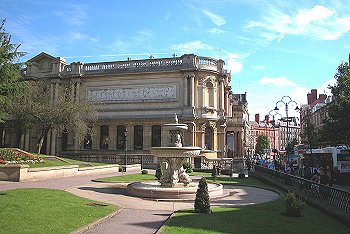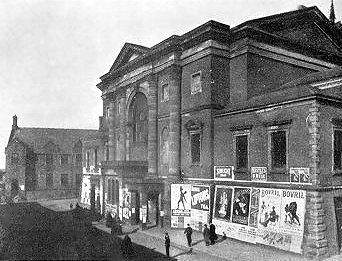|
Introduction
The term “Victorian” is one of
the most widely used descriptive words and also one of the most
imprecise. We speak of “Victorian values”, “Victorian Architecture”
and the progress of the “Victorians”. However, if we take Victorian
to mean anything appertaining to the reign of Queen Victoria, we are
speaking in terms of a period that lasted from 1837 to 1901: over
sixty years. When the young queen came to the throne, the horse was
still the main form of transport, although it was rapidly being
superseded by the railway locomotive, modern medicine was still in
its infancy and the French Revolution was still very much within
living memory. It has been noted that the British ruling class heard
the thud of the guillotine whenever they heard the cry “reform”.
When the queen died, the first tentative steps towards heavier than
air flight had been made, the motorcar was making its presence felt,
Roentgen had developed X-Ray photography and the aged queen was
captured on moving film. It is perhaps fitting that a monarch who
gave her name to a 19th century age of such vitality and forward
thinking should have died in the 20th century.
In 1901, despite the
magnificence of the Edwardian Age, when the world’s richest nation
was at last unashamed to show its wealth, the massive
self-confidence of the Victorians was beginning to crack. Doubts,
some moral, about the empire, competition from other nations such as
Germany and the United States and increasing industrial unrest, all
served to warn the far-sighted that all was not well. Therefore it
is inaccurate to speak of Victorian without some qualification, for
nothing in these years was static, as was to be expected over such a
long and rapidly developing period.
The purpose of this book is
to look at the Victorian heritage of Wolverhampton, its buildings,
artefacts and art; in the main those remaining, but also those that
only exist in memory and photograph or diagram.
|

Wolverhampton Art Gallery, one of the City's
finest Victorian buildings, amidst the hustle and bustle of a busy
Saturday morning. |
Fortunately
the former are more than, or at least as numerous as, the latter.
These range from churches to factories, civic buildings to terraced
houses and places of entertainment, for Wolverhampton has a rich
Victorian legacy and a remarkably well-preserved one. We hope that
this book will be more than simply a record of buildings, for they
are nothing without the people who created them and used them. We
therefore hope to set the buildings within the social context in
which they were built. We also hope to show how changes in society
and religion were reflected in the ways in which buildings were
presented. |
|
When we began to write this
book, we originally intended to stay rigidly within the artificial
constraints of the modern Ring Road with occasional excursions
outside. We imposed this restriction on ourselves to prevent the
book becoming too unwieldy as ever more places were drawn in.
However during the course of our researches we realised that our
“excursions” outside were becoming increasingly frequent as we found
that the work of this or that architect could be compared with a
building outside our self-prescribed brief, or that a particular
building was of such interest that it could not be passed by. The
final result is that the main body of the work is therefore confined
to the centre of the town, but the looseness of this description
will soon become apparent to readers, especially in the sections on
villas and housing.
Although when we visit a
town that is new to us, we may admire buildings and may even have a
copy of Pevsner with which to identify certain features, we tend to
take for granted the buildings in our own town; buildings that we
use every day we may not notice. We have used Wolverhampton library
for more years than we care to remember and although we have always
considered it an attractive building, had never looked at it closely
until we came to write this book. It was only then that we began to
appreciate its wealth of detail in terracotta, fine shaped windows,
remarkably beautiful interior and warm attractive woodwork.
|
|
This book then is an attempt
to bring to more people’s attention the many fine Victorian
buildings of Wolverhampton, set in the historical and social setting
in which they were built. Buildings are far more than utilitarian;
they tell us a great deal about the social scene at the time. What
was their purpose? Is there a message in the building? What lies
behind their construction? In what way do they reflect the
development of the town? We hope that we have gone some way towards
shedding light on these questions.
At the end of the book
there are biographies of all the main architects, artists and
craftsmen who either worked in or designed buildings in the town,
together with a short glossary.
|

A long gone Victorian scene. On the left is
St. Peter's School and on the right is the old Exchange, which
dominated the western side of St. Peter's church. It was demolished
in 1898. |
| We have
deliberately avoided over-burdening the text with architectural
terms and although this may lay us open to the charge of
imprecision, we feel that for the majority of readers the esoteric
nature of much architectural vocabulary would make repeated visits
to the dictionary or the glossary tedious.
The writing of this book
gave us enormous pleasure and not a few surprises as we peeped
behind familiar facades to discover unfamiliar and often delightful
interiors. As we researched the buildings and statuary of our town,
it soon became clear that Wolverhampton in the 19th century
commissioned top architects and craftsmen, and that many of the
town’s own architects went on to gain a national reputation. The
civic pride so obvious in this process continues today. We hope that
this work will encourage others to visit and see anew
Wolverhampton’s 19th century architectural heritage.
We intended this book to be a
sober appraisal of an age and buildings that we admire, therefore we
have tried to confine our ire at modern philistinism and
aggrandisement to the footnotes.
Michael Albutt and Anne Amison, Codsall 1991
Since we wrote this book it
has remained dormant whilst other publications took precedence. At
one point we assumed that the manuscript was lost and the computer
information irretrievable. Recently however we found an extant copy
of the manuscript, much to our surprise and decided to revisit it.
The main body of the text remains the same except for a few
additions and re-writings to take note of refurbishments,
demolitions (thankfully few) that have taken place since the
original manuscript was finished. One paragraph that mentions a
particularly fine building, now demolished, we could not bear to
rewrite but a poignant picture from the Express and Star tells its
own story.
Of course, since this book
was completed, the town of Wolverhampton has become a city. We have
chosen to keep the designation town for the simple reason that it
was a town during the period covered by the book. However when we
refer to somewhere in its present context then city is used.
Many of the people
mentioned in the original acknowledgements have moved on from the
town in more senses than one but help given is help given and we
would still like to express our gratitude.
Michael Albutt and Anne Amison, Codsall 2004
|
 |
|
 |
Return to
the contents |
|
Proceed to
the prologue |
|